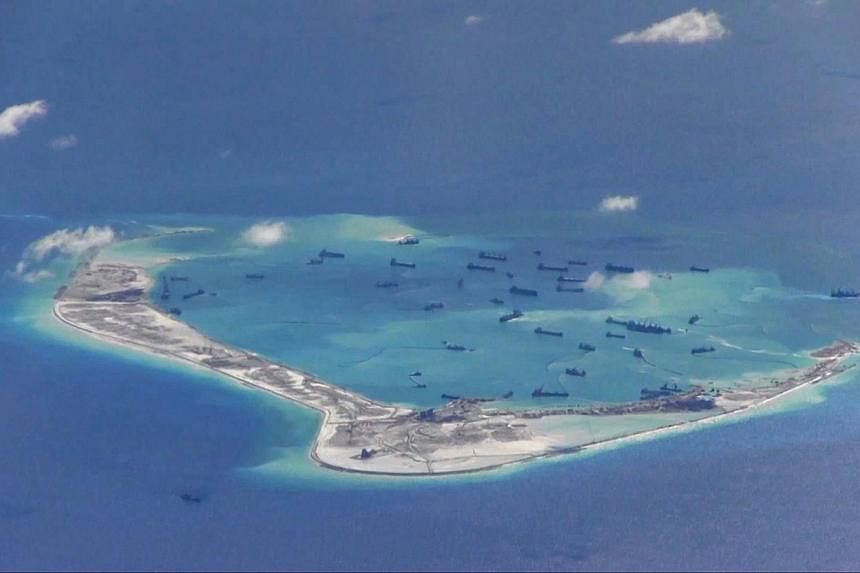It is typhoon season once again in the South China Sea. Last May, China ignited a storm of violent protest across Vietnam when it started drilling for oil off the Vietnamese coast. This year the squall is further south in the disputed waters of the Spratly Islands, where the US has demanded that China halt its land reclamation efforts. Ordered to leave the area by the Chinese military last week, a US Navy surveillance aircraft ignored the command. This brought a belligerent response from Beijing's nationalistic Global Times newspaper, which declared that a "US-China war is inevitable in the South China Sea" unless Washington backs down.
The timing of this war of words can largely be attributed to posturing ahead of last weekend's Shangri-La Dialogue, an annual security meeting in Singapore attended by military top brass from around the Asia-Pacific. Both the US and China were careful not to ratchet up tensions any further during the meeting itself. But at the heart of the spat is concern in Washington over how the US should respond to China's increasingly assertive foreign policy, the most obvious symbol of which was the recent establishment of the Asian Infrastructure Investment Bank. It is the great geopolitical question of our time: should the US accommodate China's rise or seek to contain it? How Washington responds to China's provocations in the South China Sea is a test of how it intends to answer that question.
For the US, the South China Sea matters for two reasons. First, there is the risk that a collision, accidental or not, between vessels belonging to China and one of the other claimants sparks an armed conflict. In such an event, the US might feel obliged to enter the fray-especially if it involves an ally like the Philippines. But China's new white paper on military strategy released last month makes it clear that the Chinese military will fight back if attacked. So any US military action in the region risks being perceived by Beijing as an act of war.
Second, China's expansionism in the South China Sea is increasingly viewed in Washington as part of Beijing's grand strategy to weaken US influence in the region, as Xi Jinping sets about his historic mission of restoring China's position as the dominant power in Asia (see A Dream Of Asian Empire). The US has enjoyed 70 years as the unrivaled master of the Asia-Pacific, where its powerful military presence has helped to bring peace and stability-as Singaporean prime minister Lee Hsien Loong pointed out in his opening speech at the Shangri-La Dialogue. The US is hardly going to hand over leadership of Asia willingly.
For its part, China believes that the US will do all it can to contain its rise, as former Australian prime minister Kevin Rudd explains in an excellent analysis of US-China relations. In the US's "pivot to Asia," Beijing sees proof of Washington's efforts to undermine China's position in its own backyard. Specific policies include the US's attempt to dissuade its allies from joining the AIIB, its exclusion of China from the Trans-Pacific Partnership, and its lack of impartiality in supporting the territorial claims of the Philippines and Vietnam in the South China Sea. China views US demands for it to behave as a "responsible stakeholder" as a ruse to consolidate a global order designed in the US's own interests.
So where does this leave us? War in the South China Sea remains highly unlikely. It would be devastating for both sides. China requires regional stability to deliver domestic growth and prosperity; a conflict with the US would undermine its economic rise. And as we argued last year, Beijing knows its long term goals in Asia are best served by keeping the uneasy peace and patiently establishing "facts in the water" (see Perilous Seas). China will continue to test Washington's resolve, but it has no interest in overly provoking the US. Beijing has been careful, for example, to ensure that its reclamation efforts do not threaten international shipping.
The big question is how the US responds to President Xi Jinping's muscular foreign policy in Asia. In Washington there is a growing clamour for a new grand strategy to contain Beijing. A policy paper by two former ambassadors argues that the US must do all it can to prevent China from replacing it as the dominant power in Asia, and that America should therefore intensify its naval and air presence in the South China Sea. Today, on the 26th anniversary of the bloody suppression of citizen demonstrations in Beijing's Tiananmen Square, it remains easy to sympathize with critics of the Chinese state. But a concerted effort to prevent China's rise would risk escalating tensions to genuinely dangerous levels. The US must accept China's right to play a bigger role in the world, and try to work with it to shape a new global order that serves everyone's interests. That may sound Utopian-even naive-but the alternative is far worse.
This article first appeared as a research note in Gavekal Dragonomics, the economics and research arm of Gavekal, a financial services company.

